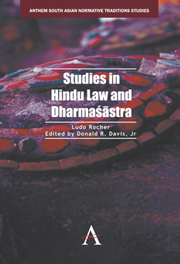Book contents
- Frontmatter
- Contents
- Foreword by Richard W. Lariviere
- Preface
- Abbreviations
- Note on the Edition
- Introduction
- PART ONE THE NATURE OF HINDU LAW
- PART TWO GENERAL TOPICS OF HINDU LAW
- PART THREE HINDU LEGAL PROCEDURE
- The Theory of Proof in Ancient Hindu Law
- The Problem of the Mixed Reply in Ancient Hindu Law
- The Reply in Hindu Legal Procedure: Mitra Miśra's Criticism of the Vyavahāra-Cintāmaṇi
- “Lawyers” in Classical Hindu Law
- Anumāna in the Bṛhaspatismṛti
- PART FOUR TECHNICAL STUDIES OF HINDU LAW
- PART FIVE ANGLO-HINDU AND CUSTOMARY LAW
- Bibliography
- Index
“Lawyers” in Classical Hindu Law
from PART THREE - HINDU LEGAL PROCEDURE
Published online by Cambridge University Press: 05 February 2013
- Frontmatter
- Contents
- Foreword by Richard W. Lariviere
- Preface
- Abbreviations
- Note on the Edition
- Introduction
- PART ONE THE NATURE OF HINDU LAW
- PART TWO GENERAL TOPICS OF HINDU LAW
- PART THREE HINDU LEGAL PROCEDURE
- The Theory of Proof in Ancient Hindu Law
- The Problem of the Mixed Reply in Ancient Hindu Law
- The Reply in Hindu Legal Procedure: Mitra Miśra's Criticism of the Vyavahāra-Cintāmaṇi
- “Lawyers” in Classical Hindu Law
- Anumāna in the Bṛhaspatismṛti
- PART FOUR TECHNICAL STUDIES OF HINDU LAW
- PART FIVE ANGLO-HINDU AND CUSTOMARY LAW
- Bibliography
- Index
Summary
There can be no doubt that parties to a lawsuit in ancient Hindu law had a right to be represented by other persons. The question arises whether or not the representative referred to in the ancient texts correspond to the pleaders, advocates, vakils or attorneys of modern India. In other words, did ancient Hindu law have the kind of legal procedure in which the rights of the parties were safeguarded through the services of a class of experts, as is the case in present day India and in most other modern legal systems?
Looking at Hindu law as it became known to the West in the latter half of the eighteenth century, it did indeed seem as if the question was to be answered in the affirmative. Halhed's Code of Gentoo Laws (1777), his translation of the Vivādārṇavasetu, did have a section (Ch. 111 § 11) explicitly called “Of appointing a vakeel (or attorney).” Its contents are as follows:
If the plaintiff or defendant have any excuse for not attending the court, or for not pleading their own cause, or, on any other account, excuse themselves, they shall, at their own option, appoint a person as their vakeel; if the vakeel gains the suit, his principal also gains; if the vakeel is cast, his principal is cast also.
[…]
- Type
- Chapter
- Information
- Studies in Hindu Law and Dharmasastra , pp. 417 - 434Publisher: Anthem PressPrint publication year: 2012



